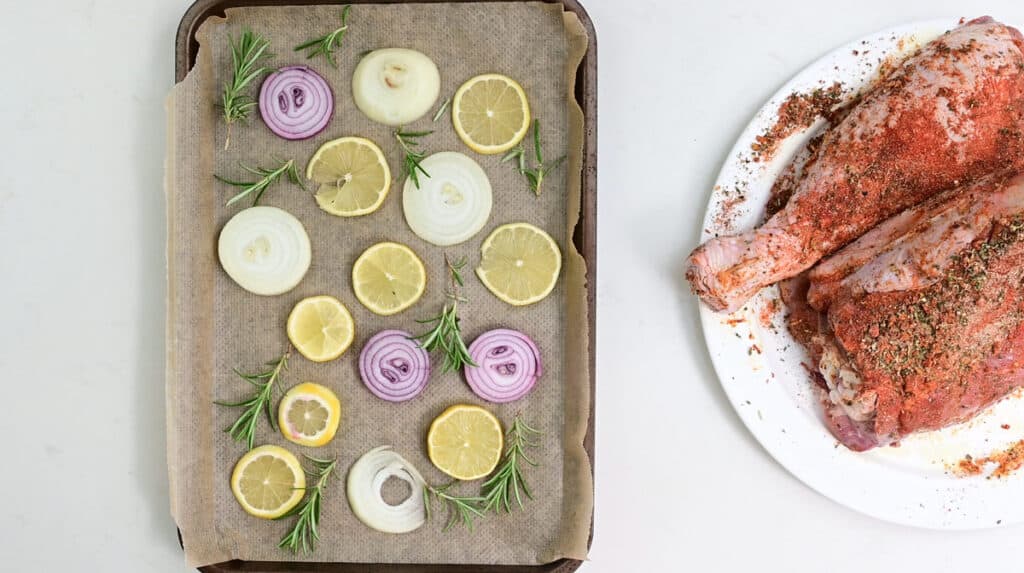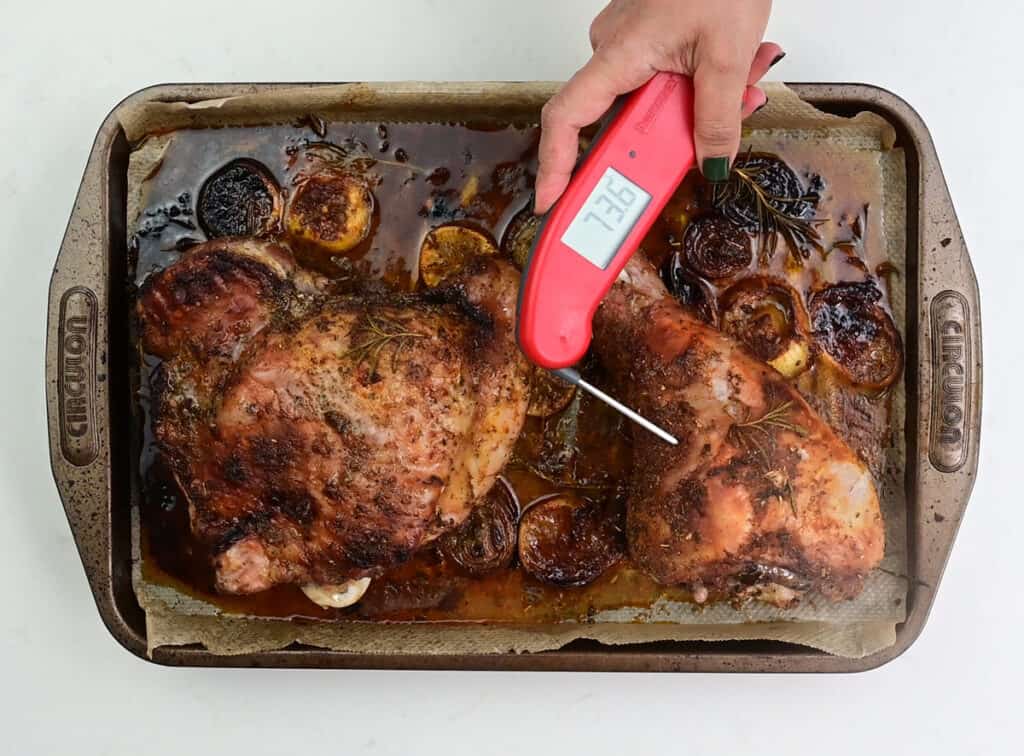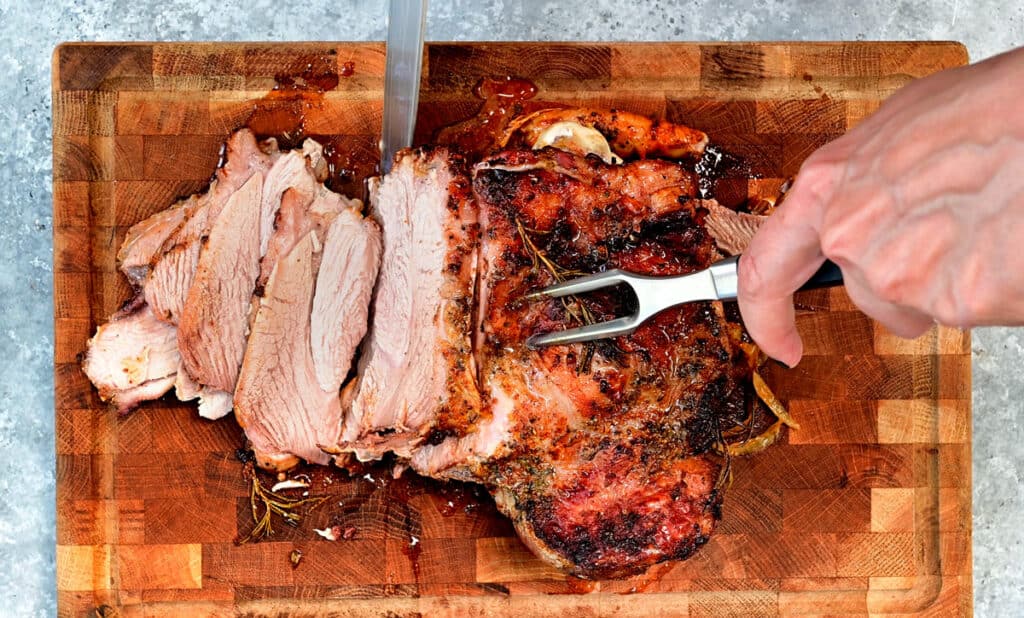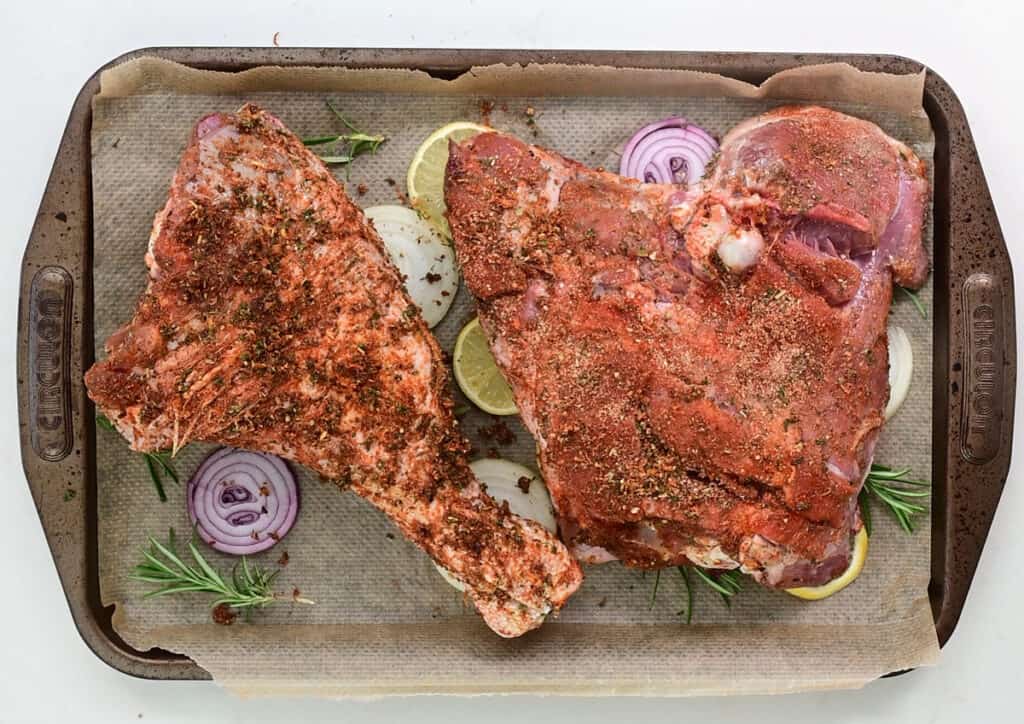Simple Roasted Turkey Legs: You can have juicy, tender turkey without roasting the entire bird by baking the legs in the oven with a recipe for perfectly seasoned oven-roasted turkey legs. In addition, anyone who has ever had a juicy turkey leg at Disney World can attest to how delicious they are.
I don’t think roast turkey is only for Christmas and Thanksgiving; it’s a great option for family dinners any time of year, and your loved ones will love the result!
But cooking the whole bird can be challenging, so when I saw huge turkey legs at my local supermarket recently, I was excited.
A whole turkey leg is much less expensive than cooking a large bird, and it can easily feed four to six people. This makes it the perfect option for small Thanksgiving gatherings or any other small holiday dinner. Even better? You will be amazed how incredibly easy it is to prepare!.
These tender turkey legs make a great alternative if you’re serving a smaller group of dark meat lovers. Forget basting, brining, and getting hot and bothered about roasting the perfect turkey! .
PS: If you prefer white meat, try my easy Roast Turkey Crown recipe! For a quick and easy alternative to a whole roast turkey, try my Turkey Roll Recipe!
You’ve come to the right place! This tutorial will walk you through the process of cooking turkey legs and thighs, from selecting the right ingredients to getting perfectly crispy skin and juicy meat.
Choosing the Right Turkey Legs and Thighs
When selecting turkey legs and thighs look for fresh, uncooked pieces that are free of any blemishes or discoloration. The skin should be smooth and elastic and the meat should be firm to the touch.
Ingredients You’ll Need:
- Turkey legs and thighs (1 pound per serving)
- Kosher salt
- Freshly ground black pepper
- Garlic powder
- Dried thyme
- Dried sage
- Paprika
- Butter, softened or melted
Instructions:
-
Prepare the Dry Rub: In a small bowl, combine the salt, pepper, garlic powder, thyme, sage, and paprika. This simple rub can be made several days in advance and stored in an airtight container at room temperature
-
Sprinkle the dry rub all over the turkey, gently working some under the skin and then pulling the skin back to cover the meat. Pat the turkey dry with paper towels. Turkey should be placed in a plastic bag with a zip-top, sealed, and refrigerated for one to two days, turning it over periodically.
-
Dry Out the Skin: The night before or earlier on the day of cooking, remove the turkey from the bag and pat it dry with paper towels. Place the turkey, uncovered, back on a baking sheet and refrigerate for at least 4 hours or overnight. This step is crucial for achieving crispy skin.
-
Preheat the Oven: Preheat your oven to 350°F (175°C).
-
Spread Butter on the Skin: Brush the turkey skin with melted butter or smear it on if you opted to soften the butter. This will help the skin brown and crisp up beautifully.
-
Roast the Turkey: Place the turkey in a baking dish and roast, uncovered, for 45-50 minutes or until the internal temperature taken in the meatiest part of the thigh or leg reads 175°F-180°F. Use a meat thermometer to ensure accuracy.
-
Let the turkey rest for ten minutes before slicing and serving it.
Tips for Crispy Skin:
- Dry out the skin thoroughly by refrigerating the turkey uncovered before roasting.
- Brush the skin with melted butter before roasting.
- If desired, broil the turkey for a minute or two at the end of cooking to achieve extra crispiness.
Tips for Juicy Meat:
- Don’t overcook the turkey. Use a meat thermometer to check the internal temperature.
- Rest the turkey before carving to allow the juices to redistribute.
Variations:
- Turkey Breast: You can use this recipe to cook bone-in, skin-on turkey breast halves. Reduce the cooking time to 165°F internal temperature.
- Seasonings: Feel free to experiment with different seasonings to create your own unique flavor profile.
Additional Resources:
- Easy Roasted Turkey Legs – Supergolden Bakes: https://www.supergoldenbakes.com/roasted-turkey-legs/
- The Most Flavorful Roasted Turkey Legs or Thighs – The Fountain Avenue Kitchen: https://fountainavenuekitchen.com/roasted-turkey-legs-or-thighs/
Cooking turkey legs and thighs is a simple and rewarding process that can be enjoyed by everyone. By following these tips, you can achieve crispy skin, juicy meat, and a delicious meal that will satisfy your taste buds.
How To Roast Turkey Legs
Full measurements and instructions can be found on the printable recipe card at the bottom of the page. Please take a look at the steps and video before attempting this recipe!.
STEP 1: Rub the turkey with olive oil. Combine all the ingredients for the rub and then sprinkle liberally over the turkey on both sides.
STEP 2: Preheat the oven to 180°C (350°F). Place foil or baking paper in a roasting pan and arrange the onion, rosemary, and lemon slices over the pan.

Step 3: Place the turkey leg on top, skin side down, and bake in the preheated oven for 30 minutes. Turn the legs over, skin side up, and continue cooking for an additional 40 minutes, or until the internal temperature reaches 75°C (167°F). This method is a great way to achieve the perfect mix of crispy skin and succulent, juicy meat.

STEP 4: Rest the turkey, loosely covered with aluminum foil, for 20-30 minutes. Slice and serve as your main dish with your favorite sides!.

Here’s what you will need
- Turkey legs – my 1. The turkey leg weighing 6 kg (3½ pounds) was divided into sections for the thighs and legs.
- Olive oil
- The seasoning rub is composed of garlic powder, oregano, dried parsley, sugar, salt, pepper, paprika, cayenne, and lemon zest.
- On a trivet made of lemons, onions, and rosemary sprigs, the turkey legs are cooked.
- Digital thermometer
- A good carving set

Easy Roasted Turkey Legs | Supergolden Bakes
FAQ
What temperature is a turkey thigh cooked at?
Should I wrap my turkey legs in foil?
How do you keep turkey legs from drying out?
Why are my baked turkey legs tough?
